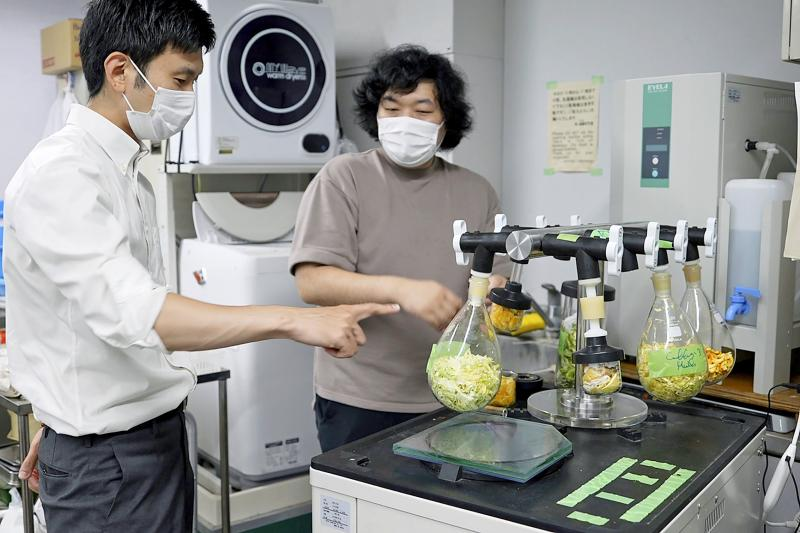Researchers from the University of Tokyo in Japan have succeeded in transforming food waste into construction cement. Their new edible material is said to be 4 times stronger than traditional concrete.
Will we ever be able to eat the walls of our homes? Scientists from the University of Tokyo in Japan Kota Machida and Yuya Sakai, have announced that they have developed ultra-strong cement by drying and compressing food waste.
The scientists used leftover Chinese cabbage, banana peels, and coffee beans to make the 100% biodegradable and potentially edible cement.
Their work was published in the Development of Novel Construction Material from Food Waste in 2021, but it was only last spring that their work was publically announced to the press.
Kota Machida has since created the company Fabula Inc and is the CEO. The patent application for this technology by the Institute of Industrial Science of the University of Tokyo is still pending.
How Did The Two Researchers Produce This Edible Concrete?
It took several attempts to get the recipe right. On their website, the researchers explain their process:
“The steps are quite simple; dry the food waste, make it into powder, then heat-press in a mold. By changing the drying and/or powdering method, and the temperature during the heat press, a variety of colors, textures, and aromas can be obtained. Mixing different food waste is also possible, as well as the creation of new materials with the use of things built with food waste.”
The article Development of Novel Construction Material from Food Waste goes into more detail about the process, which is divided into three steps:
first, they break down the raw materials (orange peels, onions, pumpkins, bananas, Chinese cabbage, and seaweed), and place them in an oven at 105°C.
the obtained dry materials are then pulverized with a blender to obtain a powder.
the powder is then mixed with water and seasonings and hot pressed at 180°C.
From raw material to new material (Credit: Fabula)
This is where the real achievement lies. Tests had previously been carried out to turn organic waste into cement, but new elements such as plastic had to be added to allow the materials to bond together. With this discovery, it is simply a matter of adjusting the temperature and pressure.
Not all types of bio-waste are potential candidates for processing into wood concrete. The researchers are currently focusing on coffee grounds, banana and orange peels, and Chinese cabbage, as they are the ones that have given the best results. Pumpkin, on the other hand, was unsatisfactory.
According to Kota Machida in a press release,
“We also found that Chinese cabbage leaves, which produced a material over three times stronger than concrete, could be mixed with the weaker pumpkin-based material to provide effective reinforcement.”
According to their calculations and strength tests, their organic concrete is four times stronger than traditional concrete, as explained on Fabula’s website:
“The bending strength of a material made from food waste of Chinese Cabbages is 4 times stronger than concrete. A 5 mm thin plate can bear 30 kg weight. It has the potential to become a construction material in the future.”
What Can Edible Cement Be Used For?
Cement is one of the most polluting construction materials. According to the British think tank Chatham House, cement is responsible for 8% of the world’s greenhouse gas emissions.
This commonly used material in construction has a significant carbon footprint due to its reliance on exhaustible resources such as gravel and sand. These resources are mined, processed, and transported, which emit greenhouse gases. Besides, the production process of concrete releases carbon dioxide.
The construction industry is aware of this and is progressively turning to more eco-friendly and sustainable building materials. New alternatives have emerged, such as wood-based concrete. But this is the first time that a building material made from bio-organic waste has been developed. This technical achievement opens up new perspectives for the construction sector.
Will we ever be able to eat our own house? The researchers have also succeeded in flavoring their concrete, making it potentially edible by people. While eating the cinderblocks of one’s house may seem like a far-fetched idea, the Japanese pair’s invention could both reduce biological waste and offer a new ecological solution to the highly polluting construction sector.
Kota Machida and Yuya Sakai in their Tokyo Lab (Picture by Associated Press)
The World Food Programme estimates that $1 trillion worth of food is lost each year. Japan is the 11th largest producer of food waste in the world. The country has the ambition to reduce its edible food waste from 5.7 million tons to 2.7 million by 2030.
Besides, this material can also be used to make smaller objects such as furniture (tables, chairs, beds).
Source: direct industry































